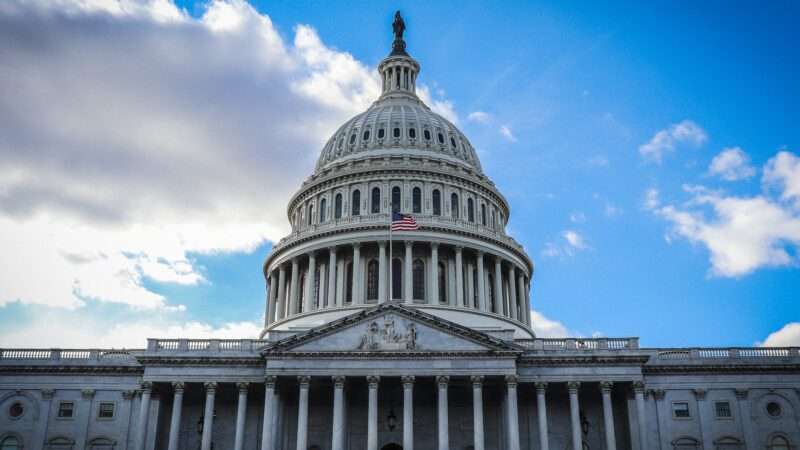
Four years ago, Grant Long, a resident of Forrest City, Arkansas, was acquitted of three criminal charges: harassment, harassing communications, and theft by receiving. In a federal lawsuit against former Forrest City police officer Darren Smith, Long argues that he was prosecuted in retaliation for his constitutionally protected criticism of Smith, who repeatedly lied in the affidavit that led to the charges.
This week a federal judge allowed Long to proceed with that claim and two others against Smith. It is not hard to see why, given the flagrantly fraudulent basis for the charges against Long, who had sued Smith in federal court and criticized him on Facebook. The case vividly illustrates how easy it is for a cop with a personal beef against someone to punish him with baseless criminal charges when prosecutors and judges fail to do their jobs by independently evaluating the allegations.
Why did Smith accuse Long of receiving stolen property? Because Long had used a Freedom of Information Act (FOIA) request to obtain a scathing June 2016 letter describing the results of an internal affairs investigation that was prompted by a personnel complaint Long’s nephew had filed against Smith a month earlier. The nephew, Derrick Long, said Smith had unlawfully entered his home, taken his dog, and stolen $900. In the internal affairs letter, Lt. E.P. Reynolds informed Forrest City Police Chief Deon Lee that “a thorough investigation” had confirmed at least two of those allegations.
“There was NO probable cause (P/C) to enter the citizen’s home,” Reynolds wrote. “Nor was there [probable cause] to seize and remove the dog from the owner’s home. The IA investigation found Officer Smith to be in direct violation of the 4th Amendment.”
Reynolds said “these violations mark yet another recent example of poor judgment on the part of Officer Smith with regard to his conduct and job performance.” He added that “there would appear to be a pattern of behavior from Officer Smith that would place our department in jeopardy of increased liability issues.”
Reynolds told Lee “the results of this most recent IA investigation (coupled with previous IA investigations) substantiate…clear violations of department protocol by Officer Smith” and “demonstrate an obvious pattern of questionable behavior and conduct on the part of Officer Smith.” Noting that Smith had already been temporarily demoted from sergeant as a result of “a previous IA investigation,” Reynolds recommended Smith’s termination.
Lee did not take Reynolds’ advice. But three years later, after Smith was promoted to lieutenant, Lee dismissed him following a complaint that he had shoved a man for no legitimate reason. WREG, the CBS affiliate in Memphis reported that Lee, who initially called Smith “a good officer” after that assault, “said there were many reasons Smith’s employment was terminated but acknowledged the shoving incident was one of them.” Previous complaints against Smith included unnecessary force against a minor, tasing a man without warning at a nightclub, and an incident in which Smith, while off duty, pulled a gun on a Walmart customer he mistakenly suspected of shoplifting.
Long included Reynolds’ prescient letter in a federal lawsuit he filed in 2018 based on Smith’s treatment of his nephew. (That lawsuit, which Long prepared without legal assistance, was dismissed without prejudice because Long had failed to establish his own standing to sue by explaining how Smith’s conduct had injured him, as opposed to his nephew.) Long also posted the internal affairs letter on Facebook. The very next day, Smith wrote and submitted the affidavit that led to the charges against Long.
In his March 2018 affidavit, Smith claimed Long’s FOIA request for the internal affairs letter “was denied due to the record being classified as a personnel record as defined in the statute.” It was therefore clear, Smith averred, that Long had “conspired with others to steal the document” and was “in possession of the stolen property.”
In reality, Lee’s office had given Long the letter, along with other documents related to the internal affairs investigation, in response to his FOIA request. “A rational juror could easily conclude Officer Smith was intentionally lying,” U.S. District Judge Lee Rudofsky notes in his March 28 order rejecting Smith’s motion to dismiss Long’s retaliatory prosecution claim. “A rational juror could conclude that there was no probable cause to prosecute Mr. Long for theft by receiving.”
Why did Smith accuse Long of “harassing communications”? In addition to publicizing the internal affairs letter, Long had posted a body camera video of a traffic stop in which Smith let a driver go after describing him as “dirty” because he had been “drinking with a CDL” (commercial driver’s license). A breath test put the driver’s blood alcohol concentration (BAC) at 0.046 percent, below the 0.08 percent level that would have made him automatically guilty of driving while intoxicated (DWI). But under Arkansas law, a BAC of 0.04 percent or more can be considered, along with other evidence, in determining whether a driver was intoxicated.
“Look at the work we pay for,” Long wrote on Facebook above the link to the video, which he had obtained from Smith’s partner, Officer Vanessa Brayboy. “SMITH LETS A DIRTY DWI DRIVER GO.”
The video revealed other questionable conduct: It showed that Smith and Brayboy were wearing each other’s body cameras during the traffic stop and switched them back afterward. “Officer Smith can then be seen manipulating the bodycam previously worn by Officer Brayboy,” Rudofsky notes. In the comment section below the video link, Long wrote that another Facebook user “couldn’t say why the officer deleted the video in the street but this is an officer who say[s] he is missing a whole mo[n]th of video.”
By Smith’s reckoning, Long’s posting of the video and the internal affairs letter, along with the accompanying criticism, amounted to “harassing communications,” which Arkansas defines to include electronic messages “likely to harass, annoy, or cause alarm” that are delivered with that purpose. While it is obvious that Long’s posts did indeed “annoy” Smith, that is not enough to satisfy the elements of this crime. If it were, the statute would be clearly inconsistent with the First Amendment.
One obvious problem with Smith’s reading of the law is that it seems Long did not deliberately “communicate” with him at all: While Smith happened to be a member of the Facebook group (“Let’s Talk Forrest City”) in which Long was participating, Long said he did not know that, and there is no evidence that he did. Furthermore, Rudofsky notes, “the record is replete with genuinely disputed material facts from which a rational juror could find that Officer Smith knowingly lied or recklessly disregarded the truth” in alleging that Long had violated the law prohibiting “harassing communications.”
Smith’s affidavit claimed, for example, that “Grant Long has continually made false statements about [me] on a public for[u]m on Facebook.” Yet as Rudofsky points out, “the record reflects one post involving the Internal Affairs Investigation Letter, one post involving the traffic stop video, and one comment to the post about the traffic stop.” Hence “a rational juror could easily conclude that Officer Smith’s use of the word ‘continually’ to describe Mr. Long’s criticisms was intentionally false.”
Smith also averred that Long “accused me falsely of letting a drunk driver continue to operate a motor vehicle after having conducted tests that show[ed] the driver was intoxicated.” But as Rudofsky notes, “a rational juror could find that Mr. Long said nothing of the sort, and that Officer Smith knew it.” Long described the driver as “dirty,” which was the same word Smith had used. Long also described him as a “DWI driver,” which was arguably true, given that his BAC was high enough to count, along with other indicators, as evidence of intoxication.
Smith said Long “public[ly] accused me of destroying evidence” and “knew when he posted such that he was posting falsehoods.” Yet “a rational juror could view the bodycam switching (between Officers Smith and Brayboy) and Officer Smith’s subsequent manipulation of one of the bodycams as evidence that Officer Smith did delete the video in the street,” Rudofsky says. “Thus, a rational juror could conclude that Mr. Long’s comment was true, that Officer Smith knew it was true, and that
Officer Smith’s description of the comment as false in the Affidavit of Arrest was a lie.”
Smith, who described Lt. Reynolds as “a former disgruntled employee,” asserted that the results of the internal investigation had been “refuted.” Yet “there is no record evidence that the findings in that letter were ever ‘refuted,'” Rudofsky says. “A rational juror could thus conclude that Officer Smith’s statement was intentionally false.”
In sum, Rudofsky says, Long “certainly didn’t communicate with Officer Smith ‘in a manner likely to harass, annoy, or cause alarm.'” And assuming Long was not aware that Smith was part of the Facebook group (which appears to be the case and is taken as true at this stage of the lawsuit), he “could not have the ‘purpose to harass, annoy, or alarm’ Officer Smith.”
Why did Long accuse Smith of “harassment”? That charge, Rudofsky says, “is even more far-fetched.” Under Arkansas law, “a person commits the offense of harassment if, with purpose to harass, annoy, or alarm another person, without good cause, he or she…engages in conduct or repeatedly commits an act that alarms or seriously annoys another person and that serves no legitimate purpose.” A “legitimate purpose,” in other words, bars this charge even when someone’s conduct “seriously annoys” another person.
“If these postings do not serve a legitimate purpose, nothing does,” Rudofsky writes. “If these postings do not serve a legitimate purpose, then the statute violates the First Amendment. Accordingly, there’s no probable cause for the harassment charge.”
As a backup to his argument that he had probable cause to accuse Long of these three crimes, Smith maintained that he was protected by qualified immunity, a legal doctrine that shields government officials from federal civil rights lawsuits when their alleged misconduct did not violate “clearly established” law. Rudofsky rejects that claim as well, since it was well-established in March 2018 that a police officer violates the First Amendment when he uses trumped-up charges to punish protected speech.
Rudofksy also allowed Long to proceed with two other claims against Smith: malicious prosecution as defined by state law and violation of Long’s “right to remonstrate” under the Arkansas Constitution. The same pattern of behavior that supports Long’s “retaliatory-inducement-to-prosecute claim under the First Amendment,” Rudofsky concludes, makes those state law claims viable as well.
The fact that Long will get a chance to hold Smith accountable for his egregious, blatantly dishonest abuse of power is encouraging. But it is more than a little troubling that a St. Francis County District Court judge approved the arrest warrant the same day Smith asked for it (a fact that Smith cited in his defense) and that local prosecutors saw fit to pursue Smith’s vendetta against Long. Even a modicum of skepticism, critical reading, and curiosity would have revealed that Smith’s accusations were driven by personal pique rather than a good-faith, evidence-supported belief that Long had broken the law. Yet somehow these officials perceived probable cause that was plainly lacking.
In his arrest affidavit, Smith repeatedly noted that Long “had full knowledge that I was a Forrest City Police Office[r].” While Smith’s status as a police officer had nothing to do with the validity of the charges against Long, it helps explain why Smith thought criticizing him was a crime and why no one bothered to correct that misconception until now.
The post A Federal Judge Says a Victim of Retaliatory Prosecution Can Sue a Cop Who Treated Criticism As a Crime appeared first on Reason.com.
from Latest https://ift.tt/9BDSQJC
via IFTTT









